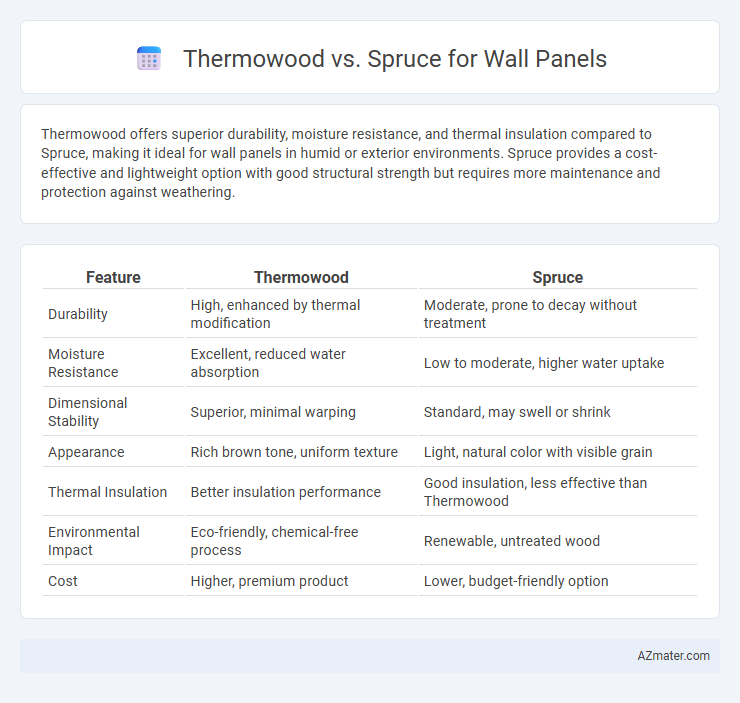Thermowood offers superior durability, moisture resistance, and thermal insulation compared to Spruce, making it ideal for wall panels in humid or exterior environments. Spruce provides a cost-effective and lightweight option with good structural strength but requires more maintenance and protection against weathering.
Table of Comparison
| Feature | Thermowood | Spruce |
|---|---|---|
| Durability | High, enhanced by thermal modification | Moderate, prone to decay without treatment |
| Moisture Resistance | Excellent, reduced water absorption | Low to moderate, higher water uptake |
| Dimensional Stability | Superior, minimal warping | Standard, may swell or shrink |
| Appearance | Rich brown tone, uniform texture | Light, natural color with visible grain |
| Thermal Insulation | Better insulation performance | Good insulation, less effective than Thermowood |
| Environmental Impact | Eco-friendly, chemical-free process | Renewable, untreated wood |
| Cost | Higher, premium product | Lower, budget-friendly option |
Introduction: Thermowood vs Spruce Wall Panels
Thermowood wall panels offer enhanced durability and resistance to moisture compared to traditional spruce panels, making them ideal for both indoor and outdoor applications. The thermal modification process of Thermowood improves dimensional stability and reduces susceptibility to decay, while spruce panels provide a natural, lightweight, and cost-effective option with a warm aesthetic. Selecting Thermowood or spruce depends on environmental exposure, desired longevity, and maintenance considerations for wall cladding projects.
Understanding Thermowood: Properties and Benefits
Thermowood is a heat-treated timber known for enhanced durability, stability, and resistance to decay compared to untreated spruce. The thermal modification process reduces moisture absorption, making Thermowood ideal for wall panels in humid or exterior environments. Its dimensional stability and improved resistance to fungal attacks offer long-lasting performance without the need for chemical preservatives.
Key Characteristics of Spruce Wood Panels
Spruce wood panels are prized for their light color, straight grain, and smooth texture, making them ideal for wall cladding where a clean aesthetic is desired. Their natural softness allows for easier installation and finishing, while offering good acoustic properties and thermal insulation. Compared to Thermowood, spruce panels require more maintenance as they lack the enhanced durability and moisture resistance achieved through thermal modification.
Durability Comparison: Thermowood vs Spruce
Thermowood offers superior durability compared to spruce for wall panels due to its enhanced resistance to moisture, decay, and insect damage achieved through heat treatment processes. Spruce, while lightweight and cost-effective, is more prone to warping, cracking, and fungal growth when exposed to fluctuating indoor or outdoor humidity levels. The thermal modification in Thermowood stabilizes the wood structure, resulting in longer-lasting wall panels with minimal maintenance requirements.
Moisture Resistance and Dimensional Stability
Thermowood offers superior moisture resistance compared to spruce due to its heat treatment process, which reduces wood hygroscopicity and increases durability in humid environments. The dimensional stability of Thermowood is enhanced, minimizing warping and swelling when exposed to moisture, making it ideal for wall panel applications in variable climates. In contrast, untreated spruce exhibits higher moisture absorption and greater dimensional changes, requiring additional treatment or maintenance to achieve similar performance.
Visual Appeal: Texture, Grain, and Color Differences
Thermowood wall panels exhibit a rich, warm color palette ranging from deep amber to chocolate brown, enhanced by a textured surface that highlights the wood's natural grain with a slightly rough, rustic feel. Spruce panels, in contrast, feature a lighter, more uniform cream to pale yellow tone with a smoother texture and subtle, straight grain patterns, offering a clean and contemporary aesthetic. Choosing Thermowood enhances visual warmth and depth through its pronounced grain and darker hues, while Spruce provides a bright, minimalist look ideal for modern interiors.
Thermal and Acoustic Insulation Properties
Thermowood offers superior thermal insulation compared to Spruce due to its modified wood structure, which reduces thermal conductivity and enhances energy efficiency in wall panels. Its porous surface also improves acoustic insulation by absorbing sound more effectively than untreated Spruce. As a result, Thermowood wall panels provide better indoor comfort through enhanced temperature regulation and noise reduction.
Environmental Impact and Sustainability
Thermowood undergoes a heat treatment process that enhances its durability and resistance to decay without chemical preservatives, reducing environmental toxins and extending product lifespan. Spruce, as a fast-growing softwood, is highly renewable and has a lower carbon footprint during harvesting but typically requires chemical treatments to boost its durability. Choosing Thermowood can support sustainability goals by combining the natural renewability of spruce with improved longevity and reduced use of harmful chemicals, resulting in fewer replacements and less waste over time.
Cost Considerations: Initial and Long-term Value
Thermowood wall panels have a higher initial cost compared to spruce due to the heat-treatment process that enhances durability and resistance to decay. Spruce is more affordable upfront but may incur increased maintenance expenses over time due to its susceptibility to moisture and insect damage. When evaluating cost considerations, Thermowood offers long-term value through reduced maintenance needs and extended lifespan, offsetting its higher initial investment.
Best Applications: Choosing the Right Wood for Wall Panels
Thermowood offers superior durability and moisture resistance, making it ideal for exterior wall panels and high-humidity indoor areas such as bathrooms and kitchens. Spruce provides a lighter, more affordable option suitable for interior wall panels in dry environments, offering a natural aesthetic with good insulation properties. Selecting Thermowood ensures long-lasting performance in demanding conditions, while Spruce excels in cost-effective, decorative indoor applications.

Infographic: Thermowood vs Spruce for Wall Panel
 azmater.com
azmater.com